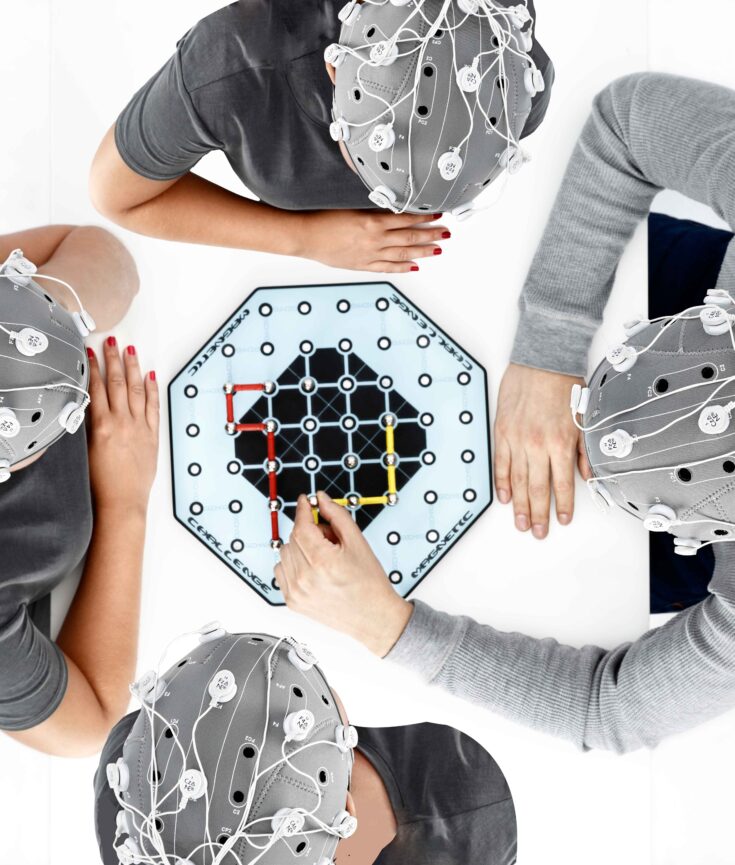Hyper-Transcranial Alternating Current Stimulation (hTACS) for Inter-Brain Synchronization During Joint Action: Techniques of Multisubject Synchronized Stimulation.
Hyper-Transcranial Alternating Current Stimulation (hTACS) has recently been investigated as a potential tool to enhance inter-brain synchronization during joint action. The coordination of brain activity between individuals is crucial for successful joint action, and hTACS offers a non-invasive and potentially effective way to modulate this synchronization. In this blog, we will explore the techniques of multisubject synchronized stimulation with hTACS, and their potential benefits for joint action.
Multisubject Synchronized Stimulation Techniques
Multisubject synchronized stimulation techniques involve applying hTACS to two or more individuals simultaneously, with the aim of enhancing inter-brain synchronization during joint action. There are several different techniques that can be used to achieve multisubject synchronized stimulation, including:
- Independent stimulation: This technique involves applying hTACS to each individual independently, but with the same frequency and phase. This technique has been shown to enhance inter-brain synchronization during joint action in a virtual ball-tossing game.
- Coupled stimulation: This technique involves applying hTACS to each individual with a frequency that is the sum or difference of their individual frequencies. This technique has been shown to improve joint performance on a decision-making task.
- Mirror stimulation: This technique involves applying hTACS to each individual with the same frequency and phase, but with the opposite polarity. This technique has been shown to improve inter-brain synchronization and joint performance on a visual detection task.
Potential Benefits
The use of multisubject synchronized stimulation with hTACS offers several potential benefits for joint action. By enhancing inter-brain synchronization, this technique could improve coordination and performance on joint tasks, as well as the speed and accuracy of joint decision-making. It could also improve social interaction, as synchronized brain activity has been shown to increase social bonding and cooperation.
Additionally, multisubject synchronized stimulation with hTACS could have potential applications in clinical settings, such as in the rehabilitation of motor impairments. The use of this technique in a social and interactive setting could be more motivating and engaging for patients, which could lead to better outcomes.
Current State of Research
The use of multisubject synchronized stimulation with hTACS is still a relatively new area of research, and more studies are needed to investigate the specific techniques that are most effective for enhancing inter-brain synchronization during joint action. The long-term effects of this technique also need to be explored, as well as its potential applications in clinical settings.
Conclusion
Multisubject synchronized stimulation with hTACS offers a promising new approach to enhancing inter-brain synchronization during joint action. This technique has the potential to improve coordination, performance, and decision-making in joint tasks, as well as social interaction and cooperation. While more research is needed, the use of multisubject synchronized stimulation with hTACS offers exciting new possibilities for improving joint action and enhancing social interaction.
Neuroelectrics offers cutting-edge hTACS devices designed to perform multisubject synchronized stimulation, enabling researchers to explore the potential benefits of inter-brain synchronization during joint action.
References:
- Kirschner S, Tomasello M. Joint music making promotes prosocial behavior in 4-year-old children. Evolution and human behavior. 2010 Sep 1;31(5):354-64.
- Szymanski C, Müller V, Brick TR, von Oertzen T, Lindenberger U. Hyper-transcranial alternating current stimulation: experimental manipulation of inter-brain synchrony. Frontiers in Human Neuroscience. 2017 Nov 8;11:539.
- Czeszumski A, Eustergerling S, Lang A, Menrath D, Gerstenberger M, Schuberth S, Schreiber F, Rendon ZZ, König P. Hyperscanning: a valid method to study neural inter-brain underpinnings of social interaction. Frontiers in Human Neuroscience. 2020 Feb 28;14:39.
- Dumas G, Nadel J, Soussignan R, Martinerie J, Garnero L. Inter-brain synchronization during social interaction. PloS one. 2010 Aug 17;5(8):e12166.
- Ahn S, Cho H, Kwon M, Kim K, Kwon H, Kim BS, Chang WS, Chang JW, Jun SC. Interbrain phase synchronization during turn‐taking verbal interaction—a hyper scanning study using simultaneous EEG/MEG. Human brain mapping. 2018 Jan;39(1):171-88.
- Valencia AL, Froese T. What binds us? Inter-brain neural synchronization and its implications for theories of human consciousness. Neuroscience of consciousness. 2020;2020(1)
